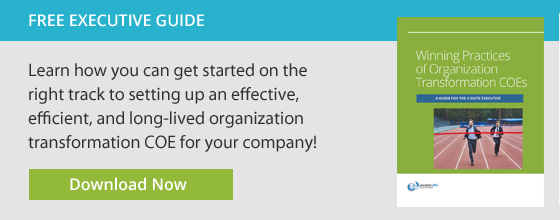Any organization, regardless of its size, type, or industry, must constantly undertake change and transformation. With the need for change comes the need for effective organization design and change transformation management to support these initiatives and ensure that they meet with success.
While these functions can be and often are outsourced, many companies are setting up internal centers of expertise (COE) in increasing numbers and with increasing capability, which are focused on helping do and manage this work. Internal COEs offer the advantage of familiarity with the organization’s business model, culture and goals. Bringing these change capabilities in house can often reduce associated costs as well. The hope is that with internal capabilities the organization will be more adept at facilitating change than if they have to find external help each time an organizational change transformation is needed.
There are many ways to set up a COE to support organization change and transformation. Unfortunately, not all COEs are effective. Based on survey data gathered from our clients, we have gained a unique window into current transformation COE trends and practices, as well as an overview of some important things organizations should consider as they plan to build or extend the reach of their COEs.
Let’s take a look at what the data reveals:
COE Placement Within Organizations
OE/talent/change COEs—or, as we prefer to call them, Organization Transformation COEs— are sometimes embedded within the business groups or units they support (meaning that they place organization transformation specialists inside one or more existing functions and/or areas of the organization.) However, it is more common for organization transformation COEs to be set up in HR.
Whether embedded in the business or shared with the whole enterprise, the majority of participants reported that their COE groups are located wholly or partially within the HR function of their organizations.
COE Funding Sources
A COE may be centrally funded with a budget, or it may be set up as a fee-for-service unit within the organization. Most organizations surveyed reported that they were centrally funded, while a few indicated that they have a hybrid approach where the client asking for their help or services may be required to fund work directly in select cases.
Even though most organizations in our survey did not utilize the fee-for-service model, there are organizations and COEs that are set up in this model. There are pros and cons of the funding model that COEs select and how that funding model influences the COE’s activities, as well as the COE clients’ behaviors and utilization patterns.
Sources of COE Work
Some COEs are set up to focus primarily on corporate change transformation initiatives; others are concerned with other types of work such as business unit or geographic initiatives. The data show a split in where COEs source work. There is a fairly even split between corporate initiatives and business unit/geographic/function-driven initiatives. Some COEs accept work from multiple sources and take a hybrid approach to work sources, but most COEs focus on either corporate initiatives exclusively or business unit/geographic/functional initiatives exclusively.
Supplementation of COE Resources
The overall trend was for a moderate amount of COE resource supplementation. This took several forms:
- Leveraging strategic partners for highly complex projects where internal COE resources may not be equipped
- Utilizing external partners to cover surges in demand or work load that couldn’t be effectively addressed by the staffing levels in the COE
- Engaging temporary support during talent gaps (e.g., while hiring permanent, full-time team members)
- Partnering with external experts to build internal capability (e.g., training, knowledge transfer, coaching, shadow consulting, etc.)
Maturity Level of Organization Transformation COEs
COE growth often occurs as a sort of wave pattern. When a COE is first formed, there will be a lot of interest in its growth and development as resources are dedicated to talent hiring and development, tool building, and other growth activities. A healthy, mature, fully established COE will then operate for a while at its peak, involved in the delivery of key projects or initiatives. This phase can last for months or years but will often be followed by a downturn and/or eventual disbandment of the COE.
Based on the data in our sample, a significant portion of survey participants indicated that they were newly formed and/or immature COEs – meaning they are in the growth phase of their COE. The remainder fell across the spectrum from developing to fully mature. The interesting note, however, is that many of the organizations that viewed themselves in the growth phase of their organization transformation COE are actually in a re-build of a COE or capability that had existed previously but had run its cycle and was now on the upswing again.
Talent and Capability Building Challenges of COEs
Many organization transformation COEs have a short life span due to a number of factors, including the following:
- Talent Shortage. There is currently a significant shortage of experienced organization transformation COE talent. For example, finding good organization design practitioners is very difficult and those that do exist are in demand. It is not unusual for competent organization transformation specialists to find opportunities elsewhere in the business or to get poached away to other organizations. Finding and keeping strong talent is not easy and is a key consideration in the building, resourcing, and sustaining of effective COEs.
- Time to Maturity. Building or growing COE talent internally takes time. If an internal team is growing its talent capability and won’t be ready to offer its services for 6 to 12 months, a potential customer in need of organization transformation assistance is likely to look elsewhere for help. This can potentially lead to a negative feedback loop where the COE gains the reputation for being ineffective before it has had the chance to develop its talent, its processes, and its tool set and prove itself.
- Training Expenses. Every COE needs a tool set – a methodology. Ideally, this should be one that is held in common between all members. In addition to the need to build or buy tools, the COE team must be trained in their use. The need for training and retraining is typically an ongoing need as turnover occurs and tools are added or upgraded.
- Economic Vulnerability. When companies hit lean times, COEs are often one of the first areas to target for reductions in funding and staffing. The COE that was so anxiously and excitedly built up a few years previously can die back almost as quickly as people leave and/or funding is retracted.
- Some business leaders use and rely on their COEs consistently. However, it’s not uncommon for business leaders to be either unaware that a COE exists, or unsure of how to leverage it. This dynamic can cause COEs to struggle from inconsistent use or exposure.
There is considerable variation from one COE to the next. However, regardless of size, type, and function, successful COEs share certain winning practices in common. In future posts, we will share more of these winning practices we have observed organizations use that have led to sustainable success in the effort to build internal organization design, talent, project management and/or change transformation capabilities.






